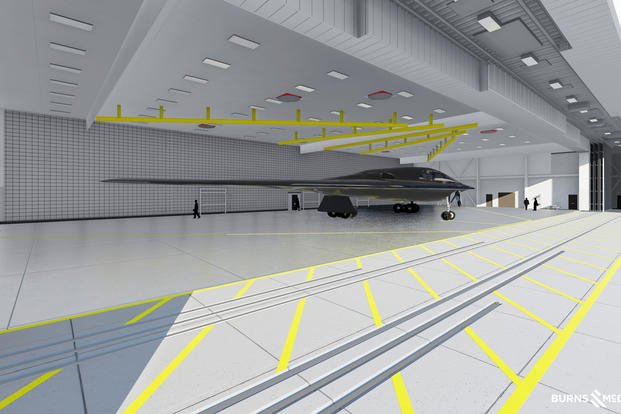The U.S. Air Force held a virtual B-21 Long Range Strike Bomber industry day this week to discuss construction projects to house the new stealth bomber, known as the Raider, according to a release.
The Air Force Civil Engineering Center and U.S. Army Corps of Engineers went over details and scheduling -- including maintenance hangars and low-observable restoration facilities -- on Monday with South Dakota's Rapid City Military Advisory Coalition, the release states.
The B-21 is still years away. The Air Force has said deliveries of the bomber, manufactured by Northrop Grumman, should begin in the mid-2020s, but the service has been careful not to broadcast details in order to protect its technology.
Read Next: Guard Troops Photographed Napping in Capitol Were on Break, Army Official Says
In 2019, the service announced that the first operational B-21 base would be at Ellsworth Air Force Base, South Dakota, which will also host the bomber's first formal training unit.
Dyess Air Force Base, Texas, is the service's preferred alternative. Dyess and Whiteman Air Force Base, Missouri, are expected to receive B-21 Raiders "as they become available," the service said at the time.
Any construction for facilities at Ellsworth and the surrounding area for B-21 support must wait until the service completes an environmental impact statement and makes a final basing decision, which is expected this year, the release states.
"We can only be successful when we proactively work as a team with our industry and community partners to ensure a common understanding of our plan, our timeline, potential environmental impacts, and the assistance that we'll need from the private sector once the [decision from the Environmental Impact Statement] is signed by the secretary of the Air Force," said John Henderson, the head of Installations, Environment and Energy for the service, in the release.
The Air Force has said it plans to procure at least 100 Raiders, rounding out its bomber inventory to 175, including its B-52 Stratofortress fleet.
However, Gen. Tim Ray, head of Air Force Global Strike Command, has often proposed a bomber force of more than 200 aircraft.
"We've said publicly that we think we need 220 bombers overall -- 75 B-52s and the rest B-21s, long term," Ray told Air Force Magazine last year.
The Raider passed its critical design review in December 2018, a pivotal milestone for the program.
-- Oriana Pawlyk can be reached at oriana.pawlyk@military.com. Follow her on Twitter at @Oriana0214.
Related: The Air Force Plans to Retrain Weapons System Officers to Be B-21 Bomber Pilots













